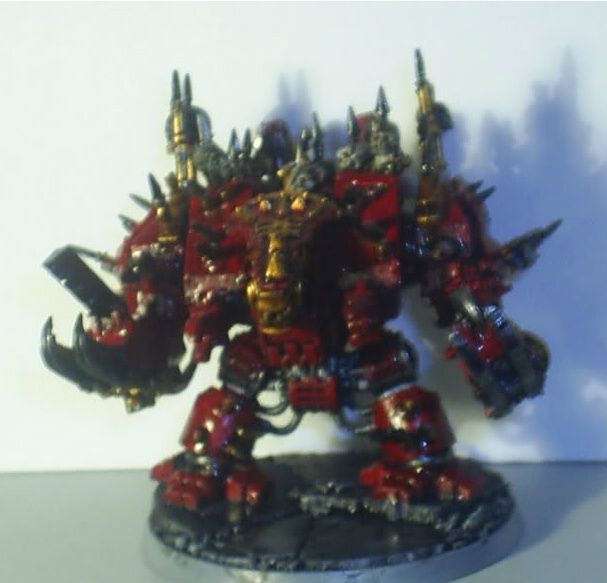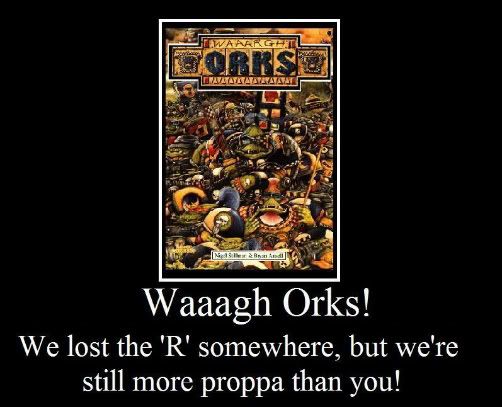Every now and then people tell you they wargame because of the game. The system, they say, is what they play for; which of course is wargaming shorthand for “I can make brutal lists and always win”. You ignore these people, if you’re not one of them, anyway. If you’re anything like me, the main reason you wargame is that you like pretty toy soldiers.
Of course, what you do with them when you get them varies, not everyone made VROOM VROOM noises when they played Krash or Dark Future, but everybody knew that the games wouldn’t be much without the toy cars to push around. Although with those games you tended to need better-looking cars. Then you needed to train your voice so that your V8 Interceptor sounded better than your riveted Cadillac...
Wargaming Miniatures (which of course is wargaming shorthand for “Toy Soldiers, pew, pew, pew! BANG! Argh!”) are a massive appeal, and over the many decades that they have existed, there have been lots of very aesthetically pleasing ones. Let’s face it; it’s the main attraction, really. The only reason I bought the board game Descent is so I could unpack and categorise all the goodies in the box.
Below is my Top 16 list (I couldn’t get it down to 15, never mind 10). It is a summarised version of my Top 25 “short-list” (that’s one thing it isn’t), which was shortened from a list of over 50 miniatures. I should note this is my list of “favourites”, or as close as I can get to it from games I have played in my time, and is limited (with a couple of exceptions) to miniatures I own or have owned. Some were eliminated from the list because I don’t own them, or because I wanted a fairly equal spread. Once I start up a few other games, the list would most likely change, so the reason it is a Top 16 is so I can at least mention Dystopian Wars and Malifaux.
On some occasions I’ve cheated, mentioning multiple models, but we’re not all perfect are we, and that’s your problem, and you’ll have to deal with it. ;)
They are of course, in descending order of preference, or audacity, I can’t remember which.
[Yes, I have been reading Cracked recently.]
16. beakie Tactical Squad [Warhammer 40,000 3rd Edition, Games Workshop]

Let’s start with something I think could actually make a place in a list of the best miniatures of all time. As a 26 year old Wargamer who has been gaming for about 17 years; I’ve had about 17 years too much exposure to beakies. But as someone who was first introduced to 40k during 2nd Edition, I had a number of beakie units, and I hated assembling them all. Every time someone complains about how annoying current GW miniatures are to assemble, I immediately think of those sodding plastic arms that you somehow had to attach bolters to, or metal heavy weapons, in such a way that they actually looked good.
I failed constantly.
Still, I was rather fond of them, but when 3rd Edition rolled along, and I saw the new plastic tactical squad, I (and probably every other gamer my age) completely forgot about every single beakie model I had seen before that. Compared to the previous ones, they were absolutely amazing, and to this day I still have no idea how GW came up with them at that time.
Ironically I only ever had one box of them. But that was the thing; I didn’t need them. My beakie army swiftly became combat orientated. The reason for that was the absolute avenue of choice that was opened up, based upon a foundation that was set by that one squad, from which all Beakies pretty much to this day originate.
I know we often blame the kiddies for beakie’s popularity, but GW really couldn’t have helped it, I don’t think. The whole of 3rd Edition made 40k a resounding success and a household name, and I think that one Tactical Squad was mostly responsible for it. It certainly killed any chance of Dark panzee doing well. Let’s face it, the Tactical Squad was selling 40k Boxed Sets single-handedly. The Landspeeder was pretty much a mess, and Dark panzee were massively unpopular (although only having the warriors in the boxed set sealed their fate).
Although the Tactical Squad box has since been refined, and added to (and had stuff removed if my friend speaks the truth), it hasn’t quite had the impact it had back then. These days we take for granted that Beakies could be put together and easily look awesome. In 2nd Ed the only thing that looked impressive was the bits of your finger stuck to the godawful “cupped hand of uselessness”. What the hell was he supposed to hold in it, a bag of frikkin’ marbles?
So there you have it, don’t blame little timmies for the popularity of the beakies – blame the beakies.
15. Aenur, Sword of Twilight [Mordheim, Games Workshop]
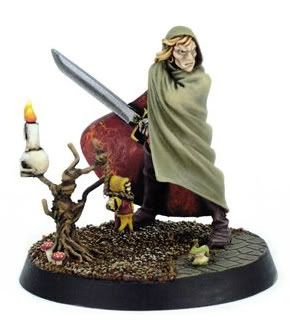
Aside of being the only Non-Dark Elf GW has produced that I have ever liked (without converting it first), it could be argued that Aenur is likely the most-painted wargaming miniature of all time. Those of you youths out there will wonder, “Why, were they giving it away?”
Well, yes, more or less, they were.
UK White Dwarf 228 had it as a free miniature. That’s right, a free metal miniature. Naturally, you could still buy it, although these days it is rather pricey. Not surprising actually, because it is bloody gorgeous. The Sword in particular is magnificent yet understated, and that cloak, which I don’t think GW has ever topped.
If you search the Internet, you’ll find lots of versions of it painted, as naturally it is the sort of miniature you just paint,
you just do.
I think part of the reason is you can tell a whole story based upon that miniature from a single glance. I still view it as Mordheim’s swansong, as I desperately try to remove the visage of the Shadow Warriors and Carnival Chaos from my mind... with
a rusty razor.
14. The Atlanteans [Dystopian Wars, Spartan Games]
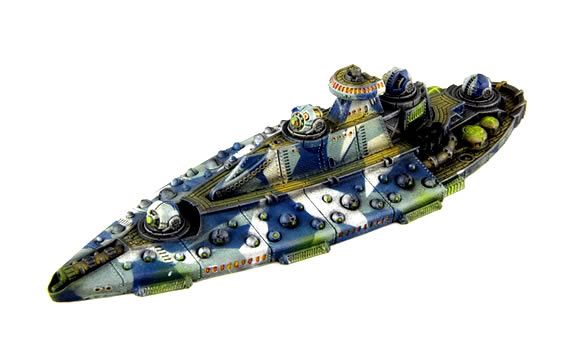
I have been looking very eagerly at Dystopian Wars, ever since I heard about it. As will become obvious throughout this article, I
love steampunk. I’ve been reading Victorian literature since I was in my early teens for pleasure and educational purposes, so Steampunk wasn’t a huge jump for me. I even listen to Steampunk music, because it is
awesome.
I also vaguely flirted with Battlefleet Gothic, but found it flawed. I’ve been waiting for a game that actually did the whole Epic and BFG thing properly, and it looks like my prayers have been answered. At the very least those miniatures are absolutely stunning, truly showing off the power of CAD sculpting. Not only does this game have a cool aesthetic, its success likely means that Spartan Games’ other game Firestorm Armada will eventually look as nice, meaning if you did want spaceship battles, you can actually enjoy it without selling your kidneys for it, and then having to watch the panzee or tin'eads urinate on your fleet.
I’ve liked parts of most of the factions on display for Dystopian Wars, even some of the American things (they have a massive walker called the
John Henry. Yeah), but up until now I’ve mostly only warmed to the Prussians (I love airships and pointy objects) and then I saw the Atlanteans…
The concept is just so damn original. I mean sure, it’s based on Verne in particular, but they look so different, yet recognisable at the same time. I truly have to thank the Podcast
All Along The Watchtower for getting me even more interested in the game,
and for alerting me to the incoming Atlanteans. As they said in the podcast, the drones do look a bit like penises, but if you avoid skin tones for your colour scheme you should be all right.
I could go on for ages about Dystopian Wars as a concept, but the obvious thing to discuss is the ridiculously amazing detail, in resin, at a reasonable cost. Just take a look at that GW. [i]That’s how you actually do it[/i].
13. The Red Gobbo [Gorkamorka, Games Workshop]
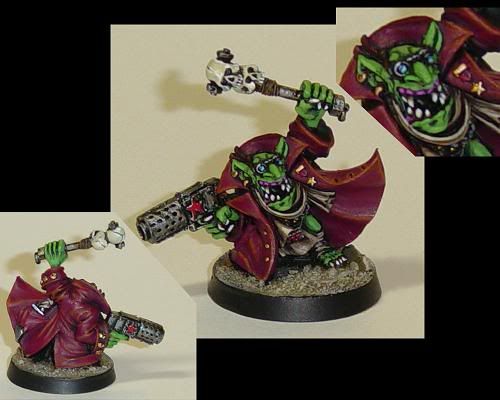
Well, as obvious choices go, this is right up there. If anyone actually wondered why the artwork for the Red Gobbo is in my avatar, I would have hoped it would be obvious, really.
Those who know me well know I have a bit of an affinity for Grots. It comes mostly from the fact that I loved Gorkamorka, and loved the idea of the Rebels. Any self-respecting Rebel player has that model (or at least did in the 90s) and it is, as far as I’m concerned, the single most stunning Gretchin model ever sculpted. The fact they discontinued it, the bile I could utter about that travesty wouldn’t begin to cover the sheer horrendous crime against grotdom that it is. At least they had the wit to keep it longer than the rest of the Rebel Grot range (apart from the regular Grots).
The Red Gobbo is from a past age, when the effort plunged into all of GW’s games was positively monumental. You might not have liked the results, but you knew they tried. A Specialist Games enthusiast can most likely tell you based upon miniatures (or an entire redux in Necromunda: Underhive) when GW stopped giving a crap. Unfortunately Gorkamorka never succeeded enough to reach that stage of ultimate failure, and as a result most of the range that was left behind is actually as collectable as most of the Necromunda range.
A honourable mention goes to the entire Rebel range, particularly the vehicles.
The metal Grots were so good the new plastics were made to fit in with them. Those were all from Gorkamorka, and they still look amazing. The vehicles, the Big Lugga and the Cutta are iconic in concept, and the ship-like motif is something I’ve expanded on for that Rebel Grot Codex I’ve been writing for Blakkreaper’s Clanz Projekt.
The only downside to the Gobbo was his staff. Although great looking, it always snaps off. Although oddly enough I have found both of the ones I lost for both my Red Gobbo models. Unfortunately one of the two is converted, ones is for GoMo (on GoMo bases, not 40k ones), so I lack one for 40k. Until I buy some instant mould ;)
Viva Da Revulushun, ya Gitz!
12. Skaven Doomwheel [Warhammer, Games Workshop]
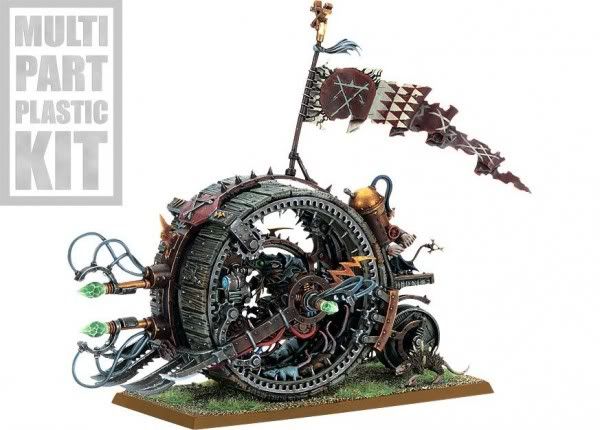
Well, I was actually on about the one from 5th Edition, but as the new one is also very pretty, and I want one (plus finding a picture of the old one was a sodding pain), so it’s not too bad of a violation of the rules I made for myself now, is it.
There are miniatures that can say a lot about you, about what kind of person, or gamer you are. Some of it is your taste, but some of it is also a little more sophisticated than that. If you played Warhammer fantasy at any point, the miniatures you had in your army was essentially a sliding scale of images that ranged from Cheddar to Stilton. Or baby-eating if you’re a Dwarf player.
If you took a Doomwheel in 5th Edition fantasy, it informed the opposing player that they should be very scared of you. Because then they instantly knew that you were above it all, that you didn’t care whether you won or lost, you had a Doomwheel, and it was going to kill things. Probably Skaven models, but your opponents always dreaded the day that the Engineer on the top wiped his goggles, because when he did, your opponent could have had all the best parts of the magic deck, the cheesy magic items, and Chaos Warriors he liked, he was still doomed.
Models like the Doomwheel represent pure insanity. They represent the exact opposite of the things I love to hate about this hobby: mathshammer, statistics, reliable/effective/viable units. The Doomwheel is the sort of thing you take when your hobby is mostly about beating your opponent to killing your own army. I’ll race you to defeatism…
You win.
There’s just something about Skaven. Their machinations, like they are in the fluff are absolutely better than everything else in the world that they exist, if only they didn’t have treacherous tendencies. I’m the kind of person who watched Wacky Races and concluded that Dick Dastardly won anyway.
Also, monowheels are cool. Crazed contraptions are better, and crazed rats riding crazed contraptions really resonates complete coolness.
11. The Orks of 2nd Edition [Warhammer 40,000, Games Workshop]
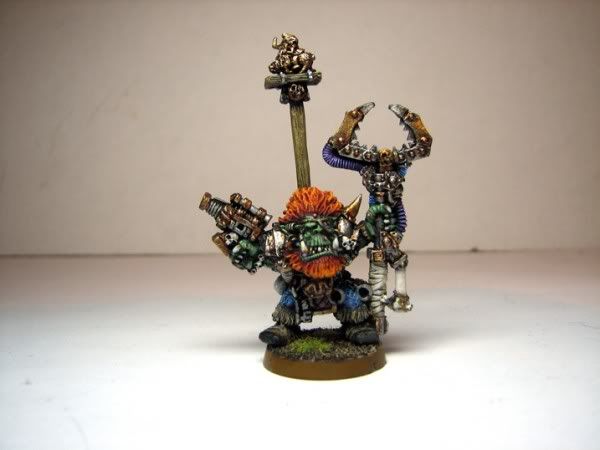
I have a confession to make. People often wonder why I have an army of Grots. It’s because I’m not really a big fan of modern Orks. I’m a 2nd Edition Ork fanboy. From then on, with the minor fluff exception of Andy Chamber’s absolutely awesome Anzion articles (although actually most of them are technically from Gorkamorka, not the 3rd Ed Codex), it has all been pretty downhill from there, really.
I still really love Orks, but I was never a big fan of the added crudity and angry-beast syndrome that overly simplified the Orks and made 40k revolve around They Shall Know No Fear and Fearless rules for about twenty billion editions. Even the models, they are still characterful, but when you contrast them with the character of the old Orks, they look positively monochrome.
My favourite model is Zodgrod Wortsnagga, the model most people know as “That cool Slaver/Runtherd model”. It is the kind of model that makes me cry inside. I look at what the Orks were, and what they have become, and know that when I come to use it, and to finally finish my Madboyz army with all the greenstuffed hair and crazed hats, expressions and demented things, I’m going to get comments in real life, and on this forum about how Orks don’t look like that and are bald, and can only have topknots.
Every time I see a RT/2nd Ed Ork army in the Mek’s Garage or Trophy Rack, I seethe with envy. I would love to have that many awesome looking Orks. Still, I have most of my favourites, Ghazghkull and Makari, the Goff Rockers, Zodgrod, the old SAG (somewhere) and recently, 2 of the 3 Tinboyz. I plan to use most of them, and I’m already working on making more Tinboyz and Rockers.
10. Wyrd Miniatures [Malifaux, Wyrd Miniatures]
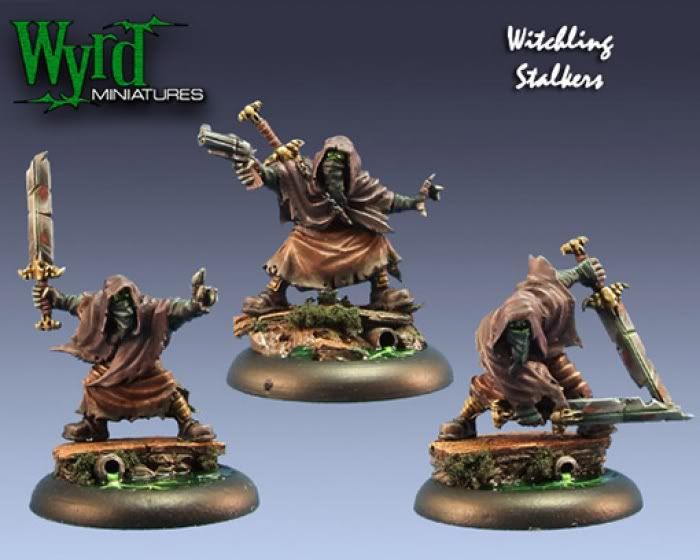
I liked Wyrd Miniatures before Malifaux was out, and I am currently cursing my horrendous poverty that I can’t buy absolutely every flipping thing they’ve made. I haven’t wanted pretty much every model in an entire range since Rackham still had stuff that was actually worth buying.
As mentioned earlier, I love Steampunk, and anything a little bit off the wall, especially if it twists popular, cultural, historical or mythological images into something vaguely different. Wyrd does this, it seems, on a daily basis. They are also the only company, since GW in the 90s to realistically get the idea of what Terrain is supposed to do, and how to design it so people can realistically, you know, use it, with wargaming bloody miniatures.
The first models to grab my attention were the Witchling Stalkers, but so much of the range is actually collectable, as well as amazingly being fit into an interesting system. Characters such as Pandora, the Mad Hatter, War, and Death, are amazing, twisted, and, well, Wyrd. There is much promise in this company, if it keeps going at this rate. And, of course, it uses proppa metal. Not cheap, overpriced resin.
9. Varghar, Limited Edition Wolfen [Confrontation 3, Rackham]
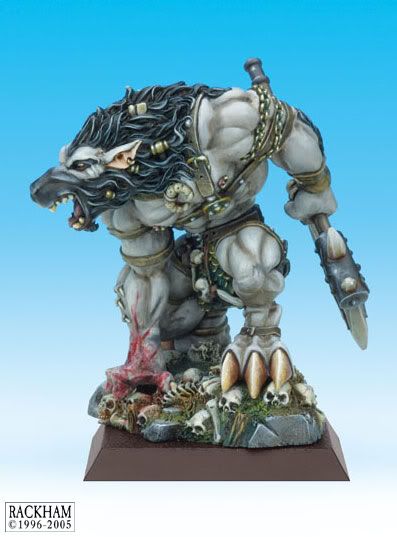
The first Rackham entry, it was only really a matter of time. It should be noted in my first list of over 50 miniatures, about half of them were Rackham models, and I hadn’t even included the Rackham models I never got a chance to actually own. So if you ever wondered why every Confrontation player in the entire planet spends most of their time in a GW store going “Meh” you are about find out a small amount about why this is.
Wolves. Ah yes, now there’s an image that can resonate. I’ve seen lots of Wolfy things in popular culture over the years, not least the actual Space Wolves, but I’ve not quite seen anything as impressive as the Rackham Wolfen.
I’m sure most of us have some kind of monstrously large creatures in our collection, things from troll/ogre size to the odd dragon and such. Rackham is the only company I have ever known to devote the detail you would expect from a tiny character model into a 55mm+ figure, and still be vaguely affordable, or designed to actually use in wargames. The Wolfen are Ogre sized, and you’re not wanting for detail, not at all.
There are of course a few really nice massive ones, their Cynwall Dragon, Midnor Daemon Tower, and the absolutely massive and disgustingly beautiful Ogre Cyclops (all of which can be easily googled), which were fairly expensive, but utterly beautiful, and I would have happily bought all of them if I had the money. They are the kind of models that, after being in a GW where some Staffer is trying to hype me into loving the Storm of Magic monsters, his face rather drops a bit when I mention the lack of detail, and the typically make-or-break GW paintwork cover-up attempt to hide it. He may wonder why this is. The one-worded answer is "Rackham".
Varghar is one of many beautiful Wolfen (Onyx, the Prowler and Predators of Blood in particular) and was a limited edition model, based on the front cover artwork of the Confrontation 3 rulebook, and managed to be more beautiful than the artwork. Only the French could pull that off. They don’t always, mind you, because Rackham’s artwork also tends to be outstanding, to the point that I bought Griffin’s Garrell the Redeemer based on his artwork picture, and was deeply disappointed.
I don’t know why I wrote so much, just look at the picture.
8. VASA Viper Wings [Void 1.1, I-Kore]
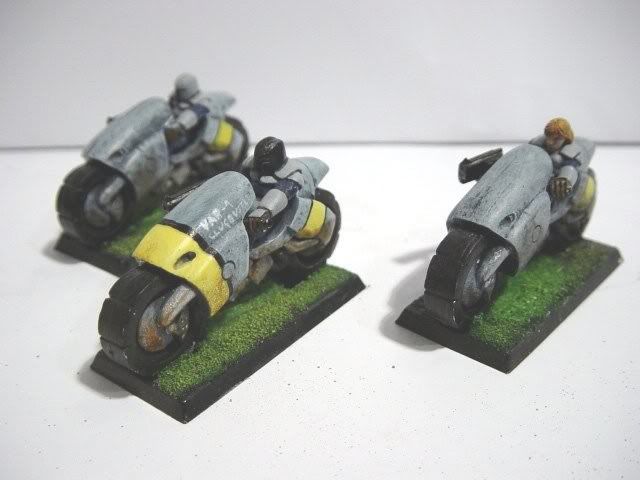
I miss Void. Mostly because I don’t remember much about it, other than me and a few friends mercilessly looting a lot of their models to use in our own systems, although we did play a bit of Void from time to time.
I-kore were the first company I encountered that produced miniatures for bikes that didn’t look like they were bricks with wheels, and made me realise that bike models could actually look extremely nice. The riders were a little bland in style, and those bikes ALWAYS fell over, but they were just utterly beautiful, and the riders didn't distract you from the appealing lines of the bikes. Of all the original Void range, they still stick out to me as the most beautiful ones.
It was a shame about Void really, because there were lots of beautiful models in that range, the Syntha and VASA tended to be the main ones, but I-kore succeeded, in the 90s, in making absolutely stunning and interesting sci-fi miniatures. These days, I actually wish I’d spent my money on Void miniatures rather than all that money I wasted on GW. I’d actually be happy to still have those models. I’ve not looked at my Beakies, or my Chaos, since I shoved them in a corner to collect dust.
Gaming truly isn’t everything.
7. Legion of Everblight Carnivean [Hordes, Privateer Press]
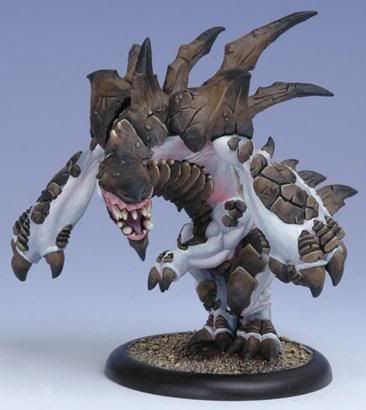
The first time I saw Everblight, I knew I’d get them. They looked like a Dragon and Daemon had shagged for a fortnight. Nothing else could be quite as awesome as that mental image.
...
Just me? Okay then...
The first time I saw the Carnivean, my jaw was sore for about 3 months afterwards. I have two of them, and they are as awesome in the game as they look. Any doubts I may have had about Hordes at the time were put to rest with a handful of models. The Carnivean is so awesome; that the Everblight range still hasn’t topped it, and it’s the one you get in the Everblight starter set.
A name I often horrendously misspell (and probably have done so again) is to thank for this beauty. One Felix Paniagua, you know, the guy responsible for Avatars of War. Yeah, him. Now you know why it looks so damn awesome.
I play Everblight mostly to put that model on the table, and I do so with horrific amounts of glee.
6. Lanyssa Ryssyll, Nyss Sorceress [Iron Kingdoms, Privateer Press]
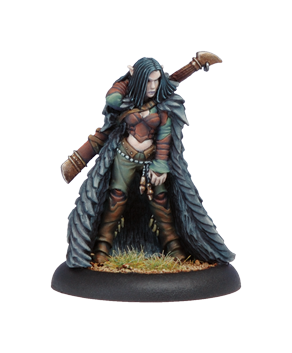
I’m sure we all have at least one model in our model collections that we bought just because we saw it and we wanted it so bad we simply had to have it. I get the sensation a lot, but I still get blown away by the beauty of this model. I do have a soft spot for Elves with a Darker ilk to it (especially Drow) but I must sadly report that I believe this is the only Elf model that PP has made that is any good.
You can now use the model in Hordes, if you’re an American, but I have still yet to decide if the best of Privateer Press is behind them. Even though I collect Everblight, I am quite disappointed with PP’s Elves since Lanyssa, and well, the models I feel, aren’t as good as they were, and the rules, questionable. Still, PP is worthy enough to be giving Games Workshop some serious competition, and one hopes they at least learn from [i]some[/i] of GW’s pitfalls.
5. Ira Tenebrae [Confrontation 3, Rackham]
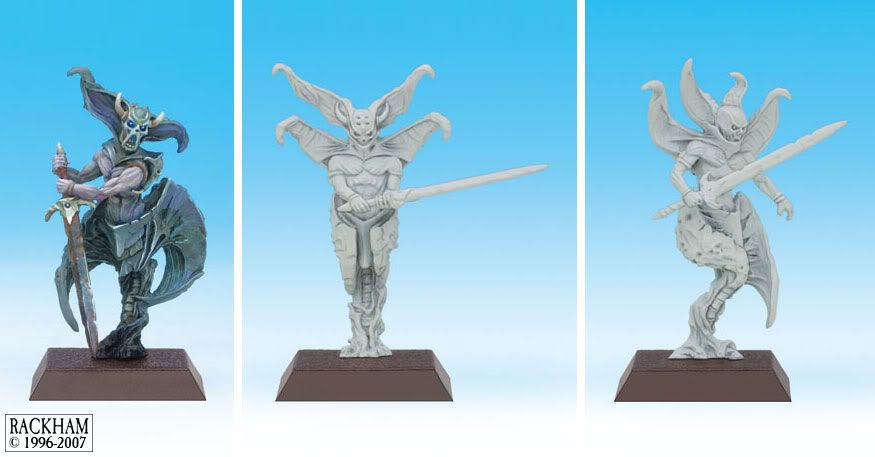
Every now and then you find models that simply strike a chord with you, and they have potentially life-changing (or wallet emptying) consequences. The Ira Tenebrae got me into Confrontation single-handedly. Aside of the fact that I love Latin; I bought a blister of 3 of the most stunning models I have ever seen for £9. For the three. No, really. At the same time, you could buy that bloody Captain Corteaz model for the same price. [i]There’s some perspective for you[/i].
I suggest googling these models. See if you can find some pictures of the back of them, because a look at the front alone does not do them justice. At the back, they have cloaks, or wings, something like that, [i]of skulls[/i]. It’s absolute insane detail. The kind of thing that makes me laugh every time I hear the pitch for “Finecast”.
In Confrontation, they are Elementals of Darkness, which requires for them to be summoned into the game, which means using the divinity rules. They didn’t get much play, let’s put it that way. But if I had to pick a model that to me had the most lasting impression, I’d pick my favourite of the 3 Ira Tenebrae. I’ve liked one in particular the most since I first saw them. Guess which one.
4. Cryx Harrower Helljack [Warmachine, Privateer Press]
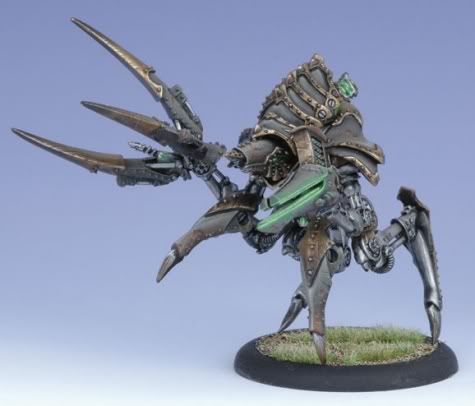
The Harrower is by far my favourite Warjack in the entirety of Warmachine. When I started Warmachine, I loved the Leviathan Helljack (Cryx call their large Warjacks Helljacks, and the Light Warjacks are Bonejacks), but found it rather understated compared to the other Helljacks. The Harrower resolutely solved my problem. It is wonderfully overstated, with a BFG and a claw that can put out your own eye, not to mention models on the table.
Never before have I actually loved a model for being a pain to transport, and being a Cryx player, it isn’t as rare a complaint as you might think. Ever since I bought it, I’ve always used it. It’s not the best Helljack out there, but it just radiates awesomeness, and cuts through troops like they’re not there, and a turn later they usually aren’t.
Cryx Warjacks tend to radiate a purely evil and unsavoury aesthetic. Honourable mentions include the Nightmare (which only just failed to get on the 25 shortlist), the Leviathan, the Slayer, and Reaper. Even the smaller “Bone Chickens” Bonejacks are cool looking, although PP ruined the Helldiver with rubbish rules, and to spite them it doesn’t rate in my Top million. Damn you PP. Your Removecontinuouseffectsdiver thing is no Helldiver.
3. Cryx Mechanithralls [Warmachine, Privateer Press]
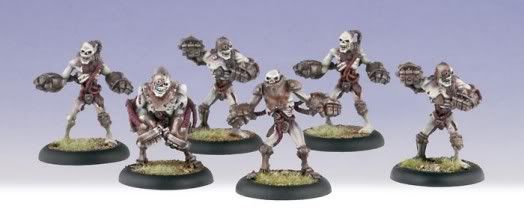
Mechanithralls are almost my favourite unit in the entirety of wargaming. Steampunk Zombies with Power Fists. It brings a whole new meaning to the phrase “You are already dead”.
I simply love the aesthetic of them, and again, with Warmachine you buy awesome models, and almost always they actually [i]are[/i] awesome. People say Warmachine is only about Warjacks and doesn’t hold a candle to 40k, but in Warmachine, units actually do something other than die. They are all good, and they can all hurt everything else. The amount of Warjacks my 20 mechanithralls have ripped through is simply hilarious.
Plus, for a gamers’ game, Warmachine and Hordes models are really quite stunning. Sure they are getting pretty damn expensive, but unlike 40k you’re not paying a premium without getting something for it. PP’s models look good, and they tend to work very well, in a system that is well written. That makes the models even more attractive. Even in Mk.2.
Warmachine is something that is very much dominated by taste. If none of the limited factions appeal to your tastes, most likely you wont pick it up, but if you do like the aesthetic, chances are you’ll love the game, and adore the models.
If I had but one complaint regarding Mechanithralls, is that there are too few poses. Still, it doesn’t make them any less awesome.
2. Hive Primus and Its Inhabitants [Necromunda, Games Workshop]


This is cheating isn’t it? I know, and I don’t care.
Top X lists need to get bigger and better, so I opted for an entire hive. Because let’s face it, Necromunda is a game of awesome models, at least until some utterly cheap and annoying twerp turns up with plastic guard, and then says something about how he wants to use them as Van Saars because they all have Lasguns, but he has ordered 50 plasma guns on ebay. Then I kill him.
Anyway, Necromunda has always been about cool models. Even before it was called Necromunda, when it was called (ironically in this context) Confrontation, there were lots of interesting models that explored a completely different style and theme within the 40k universe.
Necromunda has many beautiful models, especially the first few waves of gangs and hired guns. The later models although still usually nice enough looking, lacked the depth and scope of the original ones. Don’t get me started on the Redemption and the Ratskins, or GW’s “Sneak Peak” of the Spyrers that they never f***ing changed anyway.
Ultimately though, the best models were actually the terrain. People played Necromunda for the same reason that people played Bloodbowl over the cores. They were complete games, ones that could be set up, enjoyed, and were simple and different enough to keep the thing running to a defined outcome. And they weren’t that pretentious enough to say: “for a good game you need fancy plastic terrain that requires a second mortgage to pay for it”.
If you wanted more variation in your games, you bought more starter sets. It was that simple, and the terrain was interesting enough, and some wonderful features were chucked in by the Outlanders supplement. More to the point, Necromunda is a game you can add to, and if you had no terrain, you could play Ash Wastes instead.
Necromunda just got it right, where Inquisitor was ambitious but rubbish, and Mordheim had massive promise and a great ruleset, but the terrain just failed to live up to it. Seriously, there was better buildings in the MG “Dark Age: Village of Fear” and “Dark Age” board games, and I used them for my Mordheim games. They cost me a lot less than the 40 quid GW were charging for their boxed set at the time.
All attempts to modernise the specialist games failed and I think all non-cores these days are built to fail in the long run, as they inevitably will.
Despite this, I could write a list of favourite miniatures into the hundreds, and I’d be more likely to mention Specialist Games miniatures (mostly Necromunda ones) before 40k, LOTR or Fantasy crept in at any significant quantity.
Particular favourites of mine include the entire range of Delaques (except for the Gang leader with hair), most of the Pit Slaves, the original Scavvy range (Scalies, Karloth Valois and Plague Zombies in particular),all the Wyrd models, the creatures such as the Milliasaurs and rippa jacks, the old Redemption, both ranges of Golaiths, both ranges of Orlocks, and, well the Escher are positively iconic.
Also, did you know the Spyrers were the first introduction of fish'ead (well, their tech) into 40k? Bet ya didn’t know dat one.
1. Sentinels of Danakil [Confrontation 3, Rackham]

Yes well, put simply, I have never seen anything that comes close to these models. They blew my mind away when I saw them, and I still get blown away when I look at them. I have absolutely no criticism for these models. They are as good as gaming models get, and are closer to pure art than anything else, and yet like any fantasy gaming miniature, they are based on a purely awesome concept.
That concept is Sword Axes. That pretty much speaks for itself, doesn’t it.
It’s models like this that made pretty much the entirety of the Confrontation fanbase stop playing Confrontation when Age of Ragnarok came out, with its plastic, overpriced, boring, pre-painted miniatures. The only thing that was good about them was seeing rackham models with paint on them for a change, as I dare not, because I am to the painting fraternity of Wargaming what Matt Ward is to the fraternity of wargaming writers. In other words, I put far too much crap onto models with no particular skill, flair or ability.
Just like he does.
If you want the last word on Rackham’s legacy, it can’t hurt to find it on Coolminiornot.com. Rackham metals are the painter’s miniature of choice for showing off ridiculous skill. It isn’t surprising to see why, when you look at the canvass you’re painting on. You just bought a Finecast miniature didn’t you? Kept the receipt did you?
You’ll notice there are no current 40k or fantasy non-plastic miniatures in my top 16, nor are there any in my Top 25, nor my Top 50. Because they just don’t cut it any more, Finecast doesn’t matter, and if it does, it does so for all the wrong reasons.


